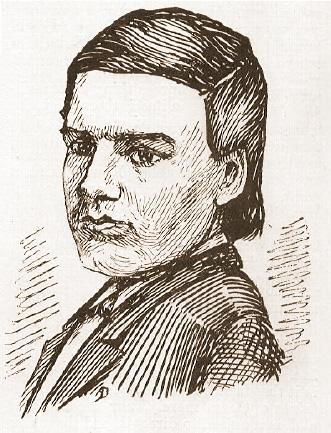
Edward Winter

James A. Leonard
Born on 6 November 1841, James A. Leonard acquired fame among his American contemporaries for his brilliant attacks and blindfold prowess, only to die in late September 1862 in Annapolis, MD before reaching even his 21st birthday. His status was recalled by James D. Séguin in the July 1906 American Chess Bulletin (page 127), a tribute to Pillsbury reprinted from the Times-Democrat (New Orleans), part second, 24 June 1906, page 12:
‘With the admitted exception of the king of chess kings, our own Paul Morphy, Pillsbury assuredly stands as the finest exponent of the game that America has yet produced – unless perhaps on a plane with him may be placed the natural (though never fairly developed) capacity of that remarkable if erratic and early eclipsed genius of the early sixties, James Leonard, of New York, whose life so soon disappeared amid the smoke and gloom of battle in the great Civil War. But, of course, lack of opportunity to attain development of genius on Leonard’s side precludes fair comparison in this instance.’
A number of games by Leonard are given below. The first was sent to us in 1998 by Jacques N. Pope, the source being The Spirit of the Times, 14 July 1860:
James A. Leonard – Lecour
New York, June or July 1860
Evans Gambit Accepted
1 e4 e5 2 Nf3 Nc6 3 Bc4 Bc5 4 b4 Bxb4 5 c3 Bc5 6 O-O d6 7 d4 exd4 8 cxd4 Bb6 9 Bb2 Nf6 10 Nbd2 O-O 11 e5 dxe5 12 dxe5 Nd5 13 Ne4 Be6 14 Qc1 Nce7 15 Nfg5 h6 16 Nf3 Kh8

17 Nf6 gxf6 18 Qxh6+ Kg8 19 exf6 Resigns. A computer check shows that after 19…Nf5 White would have given mate in, at most, eight moves.
The sketch of Leonard reproduced above appeared on page 320 of Brentano’s Chess Monthly, November 1881, an issue which also gave some of his games, presented by Miron Hazeltine. (The material had originally been published in the Macon Telegraph in 1867.) Leonard’s main haunt was the Morphy Chess Rooms in New York, on the south-eastern corner of Broadway and Fourth Street, and Hazeltine remarked that Leonard was the Rooms’ ‘light and lustre’. It was there that, in the summer of 1860, he won the second New York Handicap tournament, from a field which included the even younger George H. Derrickson. Leonard defeated J.P. Barnett (1831-86) in the deciding match:
James A. Leonard – James Parker Barnett
New York, July or August 1860
Evans Gambit Accepted
1 e4 e5 2 Nf3 Nc6 3 Bc4 Bc5 4 b4 Bxb4 5 c3 Ba5 6 d4 exd4 7 O-O Nf6 8 cxd4 O-O 9 e5 Ne8 10 d5 Ne7
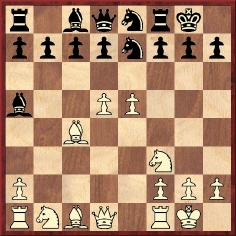
11 d6 Ng6 12 Bg5 Nf6 13 exf6 gxf6 14 Bh6 Re8 15 Qd5 Re6 16 Qxa5 Rxd6 17 Nc3 b6 18 Qf5 Rc6 19 Qd5 Rxc4 20 Qxc4 Bb7 21 Qg4 d5 22 h4 Bc8 23 Qg3 d4 24 Rad1 Qd6 25 Qxd6 cxd6 26 Rxd4 Resigns.
Source: Brentano’s Chess Monthly, November 1881, page 322.
Another victim during Leonard’s short career was William Horner, who had been the victor in the Minor tournament at New York, 1857 while Morphy had been winning the main event.
William Horner – James A. Leonard
New York, 1860 or 1861
Giuoco Piano
1 e4 e5 2 Nf3 Nc6 3 Bc4 Bc5 4 c3 Nf6 5 d4 exd4 6 e5 d5 7 b4 Bb6 8 Bb5 Ne4 9 cxd4 O-O 10 Bxc6 bxc6 11 O-O f6 12 exf6 Qxf6 13 h3 Bxh3 14 gxh3 Qxf3 15 Qxf3 Rxf3 16 Kg2 Raf8 17 Be3
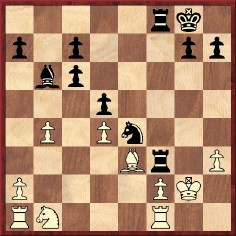
17...Nxf2 18 Bxf2 Rxf2+ 19 Rxf2 Rxf2+ 20 Kxf2 Bxd4+ 21 Kf3 Bxa1 22 White resigns.
Source: Brentano’s Chess Monthly, November 1881, page 323.
The next game was sent to us by Jacques N. Pope from The Dial, 4 October 1861:
James A. Leonard – Leopold Mark
New York, 1861
Scotch Game
1 e4 e5 2 Nf3 Nc6 3 Bc4 h6 4 d4 exd4 5 O-O d6 6 Nxd4 Ne5 7 Bb3 c5 8 f4 Nc6 9 Qh5 g6 10 Qd5 Qc7 11 Nb5 Qd7 12 e5 Nb4 13 Nxd6+ Bxd6 14 Qxd6 Qxd6 15 exd6 Be6 16 a3 Bxb3 17 axb4 Bxc2 18 bxc5 f5 19 b4 Nf6 20 Nc3 a6 21 Re1+ Be4 22 Bb2 Rf8 23 b5 Kd7 24 Na4 Nd5
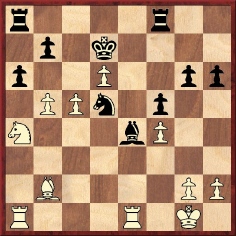
25 c6+ bxc6 26 Nc5+ Kxd6 27 Ba3 Rfe8 28 Nxe4+ Kd7 29 bxc6+ Kxc6 30 Rac1+ Kb6 31 Bc5+ Kc7 32 Ba7+ Kb7 33 Nd6+ Kxa7 34 Nxe8 Nxf4. It is mate in five (35 Rc7+ Kb6 36 Rb1+ Ka5 37 Rc2, etc.).
In Brentano’s Chess Monthly (op. cit.) Hazeltine referred to Leonard’s ‘wonderful blindfold séances in the Fall of 1861, the Winter and Spring of 1862’. The next game, from Brentano’s Chess Monthly, November 1881, page 324, was one of eight played simultaneously without sight of the board:
James A. Leonard (blindfold) – Hoffman
New York, 11 December 1861
Centre Game
1 e4 e5 2 d4 exd4 3 Nf3 Bc5 4 Bc4 Qf6 5 O-O h6 6 c3 Nc6 7 e5 Qg6 8 cxd4 Bb6 9 d5 Nb4 10 a3 Na6 11 Nc3 Ne7 12 Nh4 Qh7 13 d6 g5 14 dxe7 gxh4 15 Nd5 Qg6 16 Be3 c5 17 f4 Rg8 18 Qf3 Nc7
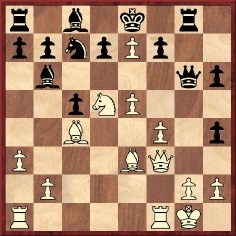
19 f5 Qg7 20 Nf6+ Kxe7 21 Nxg8+ Qxg8 22 Bxh6 Ne8 23 Qh5 d6 24 Qxh4+ Kd7 25 Rad1 Kc7 26 f6 Bd7 27 Bf4 Bc6 28 exd6+ Kd8 29 Qg5 Qh7 30 Rfe1 Qc2
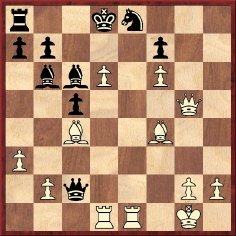
Here Leonard announced a less-than-obvious mate in five beginning with 31 d7.
The most games Leonard played blindfold was ten, the first such occasion being on 16 November 1861.
Next, a gamelet which was formerly the sole familiar specimen of Leonard’s play:
James A. Leonard – Joseph Leonard
Occasion?
(Remove White’s rooks at a1 and h1.)
1 d4 d6 2 c4 e5 3 e3 c5 4 d5 Nf6 5 Nc3 Bg4 6 f3 Bh5 7 Nb5 Ne4 8 Qa4 Nf6

White mated in two moves.
In the following century the score was published by Claudius Hüther (Schnell Matt!, page 100) and by Kurt Richter (666 Kurzpartien, page 10 – he called it ‘a text-book example of the power of double check’), without any date, giving ‘J.A. Leonhard’ [sic] as White and with no identification of Black, who was James’ brother, Joseph. The latter was described by Hazeltine (on page 368 of the December 1881 Brentano’s Chess Monthly) as ‘a nice, good-natured, rollicking boy, vehemently devoted to three laudable objects – Muggins, the Morphy Chess Rooms, and his brother’.
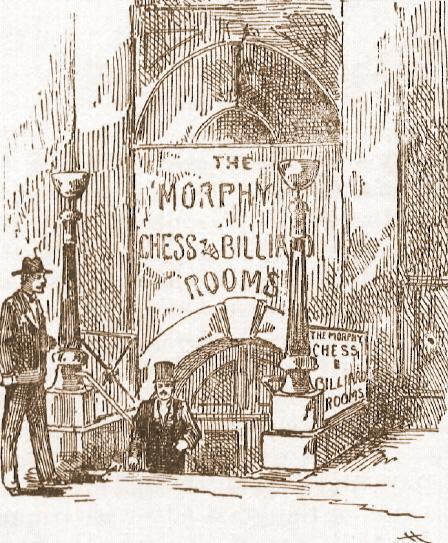
William Richardson, J. Southard and Leopold Mark – James A.
Leonard, H.P. O’Neil and J.G. Greene
New York, 1861
Giuoco Piano
1 e4 e5 2 Nf3 Nc6 3 Bc4 Bc5 4 c3 Nf6 5 d4 exd4 6 cxd4 Bb4+ 7 Bd2 Nxe4 8 Bxb4 Nxb4 9 Bxf7+ Kxf7 10 Qb3+ d5 11 Qxb4 Re8 12 Ne5+ Kg8 13 Qb3 Nxf2 14 Kxf2 Qh4+ 15 Kf1 Qxd4 16 Nf3 Rf8 17 Na3 b6 18 Nb5 Ba6 19 Rc1 c6 20 Rxc6 Bxb5+ 21 Qxb5 Qd1+ 22 Kf2 Qxh1 23 Qxd5+ Kh8 24 Kg3 Rae8 25 Rc7 Re2 26 Ng5 Qe1+ 27 Kg4
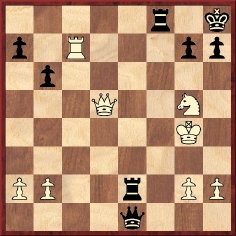
27…h5+ (A computer suggestion is this unusual variation: 27…Rf4+ 28 Kxf4 Qh4+ 29 Kf3 Rf2+ 30 Ke3 Qf4+ 31 Kd3 Rd2+ 32 Kc3 Qe3+ 33 Kb4 Rxb2+ 34 Ka4 b5+ 35 Qxb5 Rxa2+ 36 Kb4 a5+ 37 Qxa5 Rb2+ 38 Kc4 Rc2+ 39 Kb4 Qd4+ 40 Kb3 Qb2+ 41 Ka4 Qa2+ 42 Kb5 Qd5+ 43 Ka6 Qa8+ 44 Kb5 Qb8+ and wins.) 28 Kxh5 Re5 29 Rf7 g6+ 30 Kxg6 Rg8+ 31 Kf6 Rexg5 32 Qxg5 Rxg5 33 Kxg5 Qd2+ 34 White resigns.
Leonard came onto the chess scene just as Morphy was easing himself out of it. On page 262 of his biography of Morphy, David Lawson stated that in New York in October 1860 ‘Morphy met J.A. Leonard and Otto Michaelis, offering both the queen’s rook’. (The game, which has not been found, was drawn.) Leonard played most of his chess in New York, although he did visit Philadelphia in 1861 for a match against William Dwight (1831-88), who later became a General. With Leonard leading by +6 –3 =2 and requiring only one more win, the match was left unfinished and he returned to New York.
James Séguin was not alone in ranking Leonard among America’s very best. According to page 8 of Reichhelm’s Chess in Philadelphia (published in 1898), Leonard ‘was, after Morphy, the most promising player America ever produced’. But then came the Civil War, and Leonard was gone, at the age of 20. The circumstances were reported by Hazeltine in the Macon Telegraph of 1867:
‘Moved in an evil hour – by what mocking friend we know not - he enlisted on 1 February 1862 to Company F., 88 N.Y. Volunteers, an Irish Regiment. He was in the battle of Fair Oaks, and in the seven days’ battles, till that of Savage’s Station where he was captured. Though detained less than three months, so ill would his frame bear the unavoidable hardships that he was attacked with fever and scorbutic dysentery and died at Annapolis. … The sad intelligence of his death was conveyed to the writer by his brother, who with his now doubly bereaved mother repaired to Annapolis to soothe his last moments. But before reaching him, on 26 September, his spirit departed. He remembered with blessings his friends in his last hours.’
In Brentano’s Chess Monthly, December 1881, page 369, Hazeltine recalled that Leonard’s ‘favorite pupil’, E.W. Bryant, ‘never tires of recording Leonard’s games, or of taking lessons from him, or of penning his praises in his letters’ and that ‘the chess world is indebted to him for the score of many of his young master’s games, which would otherwise have been lost’.
The article above is a heavily-abridged version of various items we wrote about Leonard between 1998 and 2005. See, in particular, pages 133-140 of Kings, Commoners and Knaves, pages 93-96 of A Chess Omnibus and pages 62-63 of Chess, Facts and Fables. Subsequently, in C.N. 4087, we noted the publication of The Tragic Life and Short Chess Career of James A. Leonard, 1841-1862 by John Hilbert (Jefferson, 2006), which comprises a detailed biography and 92 games, including the following two:
James A. Leonard – William G. Thomas
Philadelphia, 1861
Philidor’s Defence
1 e4 e5 2 Nf3 d6 3 d4 exd4 4 Qxd4 Nf6 5 Nc3 Be7 6 Be3 O-O 7 O-O-O Nc6 8 Qd2 Bd7 9 Bd3 a6 10 h3 b5 11 Nd5 Nxd5 12 exd5 Ne5 13 Nxe5 dxe5 14 f4 Bd6 15 f5 Qe7 16 g4 f6 17 h4 a5 18 g5 a4 19 h5 b4

20 h6 Rfb8 21 hxg7 b3 22 a3 Bxa3 23 c4 Bxb2+ 24 Qxb2 a3 25 Qh2 Qxg7 26 gxf6 Qf7 27 Rdg1+ Kh8 28 Rg7 b2+ 29 Kd2
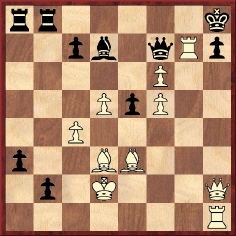
29...b1(N)+ 30 Bxb1 Rb2+ 31 Bc2 Rxc2+ 32 Kxc2 Bxf5+ 33 Kc3 Qxf6 34 Qxh7+ Bxh7 35 Rhxh7 mate.
The second game has an unusual sacrificial motif at move 24:
James A. Leonard – Thomas Loyd
New York, 1861
Evans Gambit Accepted
1 e4 e5 2 Nf3 Nc6 3 Bc4 Bc5 4 b4 Bxb4 5 c3 Ba5 6 d4 exd4 7 O-O Nge7 8 cxd4 d5 9 exd5 Nxd5 10 Ng5 O-O 11 Nxh7 Kxh7 12 Qh5+ Kg8 13 Bxd5 Bb6 14 Nc3 Nxd4 15 Bg5 Qd6 16 Qh4 Ne2+ 17 Nxe2 Qxd5 18 Rad1 Qe5 19 Nf4 f6 20 Ng6 Qe8 21 Qh8+ Kf7 22 Qh5 fxg5 23 Nxf8+ Kxf8
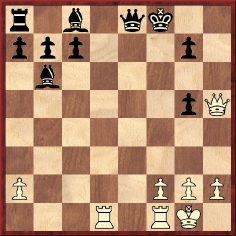
24 Rd8 Qxd8 25 Qh8+ Ke7 26 Qxg7+ Ke6 27 Re1+ Kf5 28 Qf7+ Kg4 29 Qf3+ (29 Re4 mate.) 29...Kh4 30 g3+ Kh3 31 Qh5 mate.
Finally, as noted in C.N.s 3020 and 3451, a second picture of Leonard is known to exist. It appeared (in minuscule form) in Chess Amateur page headings (e.g. on page 150 of the March 1914 issue):
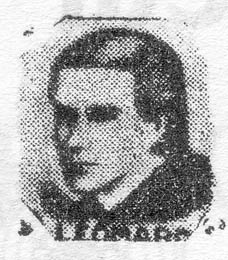
We are still looking for a good, proper-sized version.

With the permission of McFarland & Company, Inc., our Foreword to John Hilbert’s book is reproduced here:
The chess historian is a free agent who may go wherever he pleases, constrained only by the wish, and need, to present something fresh. If his specialty is biography, for instance, he may choose to focus on a well-known master, but will then delve deeply, going far beyond the well-trodden path. Alternatively, and sometimes even more satisfyingly, he may select a figure never previously accorded full-scale biographical treatment.
Until recently, the name of James Leonard was unfamiliar to most chess enthusiasts. There were occasional references in passing to a brilliant young blindfold expert viewed as a possible successor to Paul Morphy, but scant particulars were readily available about him. His name did not appear in chess encyclopedias, and his games were absent from books and databases.
In the late 1990s, Leonard began to receive recognition, although it could hardly have been imagined or hoped that, within just a few years, he would become the subject of a comprehensive monograph. That such a book has now come about is, of itself, testimony to the skill and drive of Dr Hilbert, who has investigated Leonard with his usual thoroughness, reliability and even-handedness. In so doing he has unearthed a remarkable amount of information and many fine forgotten games.
There emerges a portrait of an engaging, talented chess lover who could indeed legitimately aspire to fill the gap left by Morphy’s withdrawal, at least in his homeland and possibly beyond. Yet while Leonard remains the focus of attention in these pages, the broader tableau of US chess in the early 1860s is also ably presented. So too is the agony of the Civil War, which cost Leonard his life.
It is curious to reflect that, in other circumstances, James Leonard might still have been in active play during the First World War. After all, J.H. Blackburne, another blindfold specialist, was born the same year as Leonard and participated in the St Petersburg tournament of 1914. But Leonard, fêted in his teens, was dead at 20. Almost a century and a half later, Dr Hilbert has paid him a magnificent tribute.
In 2014 McFarland published a paperback edition.
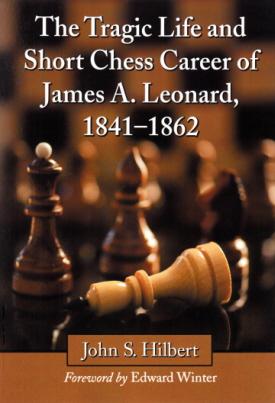
Concerning the ‘Sneak’ opening reference attributed to Leonard, see C.N.s 8368 and 8386.
From John Hilbert:
‘Just recently Joost van Winsen brought it to my attention that a photograph of Leonard now appears in the digital collection of the Cleveland Public Library.
On page 187 of my 2006 book on Leonard I wrote:
“That same day [12 April 1862], Hazeltine published a brief thank you in his Clipper column to the Morphy Chess Rooms’ Klatzl: ‘Received with most hearty thanks; a photograph of our friend Leonard is something to brag of, and goes among the choicest of our chess treasures.’ Photographs of Leonard were difficult to obtain even at the time. Hazeltine would later write, in 1867, that ‘We know not that more than one likeness of the departed was ever taken. The Appletons had him on their list of cartes de visite: but a friend, we understand, soon bought them all up, and they are now extremely rare.’ Ironically, then, one friend’s love of Leonard, in wishing to remember him, has made it harder for posterity to do the same. No photograph of Leonard has ever been found. The one, poor line engraving of him appearing in this volume, taken from Brentano’s Chess Monthly, is all that remains.”’
With the permission of the Cleveland Public Library we reproduce the photograph:
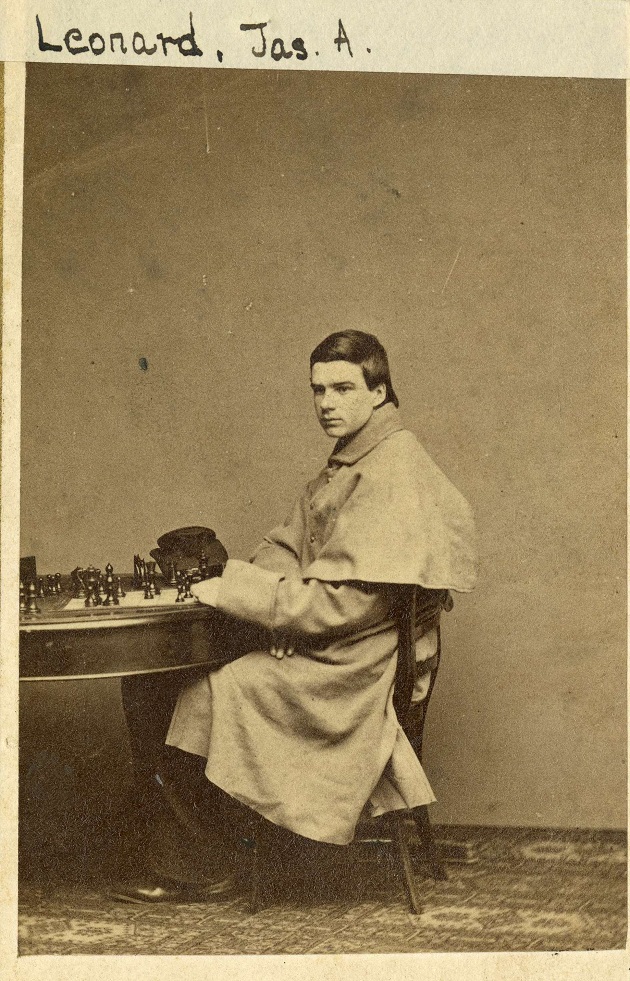
(10656)
Regarding James Parker Barnett, see C.N. 11398.
To the Chess Notes main page.
To the Archives for other feature articles.
Copyright: Edward Winter. All rights reserved.